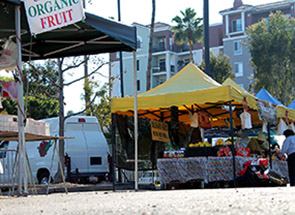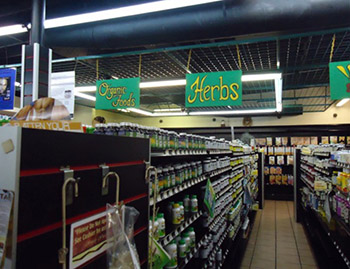By Daniella Segura
Moving to South Los Angeles from her home of 18 years in Los Feliz, Marie-Alise de Marco expected many changes, but the lack of healthy food options in her new community was not one of them.
De Marco, 50, a manager at the Crenshaw Farmer’s Market, said she has always been health conscious, making sure what she makes for her husband and two boys are healthy. She tries to buy organic foods to prepare for her family and avoids other foods infused with pesticides and hormones. 
De Marco recalled how she went to a Ralph’s market in South L.A. to buy groceries for her family, soon after moving to the area in the fall of 2009. There was no organic milk or blue cheese that she wanted.
“It was just mind boggling that there was no choice,” she said. “There was nothing healthy, nothing organic…if you would have taken the name Ralph’s off that store, I wouldn’t have known I was at a Ralph’s.”
De Marco isn’t the only one affected by the lack of healthy options in South L.A. The region has long suffered from a lack of diversity in dining options.
About 70 percent of the restaurants in South L.A. are fast food restaurants, far higher than areas such as West L.A., where the figure is about 40 percent, according to the Community Health Councils, a non-profit, community-based health education and policy organization.
Paul Simon, director of the L.A. County Department of Public Health’s Division of Chronic Disease and Injury Prevention, said the abundance of fast food restaurants contributes to the high obesity rates in South L.A.
In 2011, about 33 percent of adults in South L.A. were obese, which is an estimated 12 percentage points higher than Los Angeles County’s overall rate, according to reports by the L.A. County Department of Public Health.
“We think [the obesity rate] reflects the types of foods that are available in that community,” Simon said. “It’s a very low income area of the county, and it seems to be filled with foods that are prone to making people overweight.”
City officials have recently taken measures to address the problem; passing a fast food moratorium that restricts the building of stand-alone fast food restaurants in South L.A.
Since the start of the ban in 2007, obesity rates among adults in South L.A. have fallen by about 3 percentage points, according to reports by the L.A. County Department of Public Health. The decrease marked the largest fall in obesity for any area in L.A. County since 2007. Yet up until 2011, South L.A. had the highest obesity rates for L.A. County.
Antelope Valley is now marked with the unwelcome distinction as the county’s most obese area, according to a report by the L.A. County Department of Public Health.
Breanna Morrison, a health policy analyst at Community Health Councils, said a number of factors helped prompt the decrease in obesity, including the fast food ban.
“Part of the idea behind the fast food regulation was to not concede to allow McDonald’s and these other restaurants to monopolize the very little undeveloped land that we have left in South L.A.,” Morrison said. “Instead, let’s preserve it for the development of healthier alternatives.”
Since 2007, there have been six new grocery stores erected in South L.A., Morrison said. Among the newly built grocery stores are a Fresh and Easy Neighborhood Market on Adams Boulevard and a Farm Fresh Ranch Market on Vermont Avenue.
She also said that from 2007 to 2009, the percentage of adults who consumed fast food in South L.A. four to five times per week fell about two percentage points, according to surveys done by the Community Health Councils and L.A. County Department of Public Health.
Morrison said the fast food ban was a good first step toward making South L.A. a healthier community, but she says more needs to be done, including building more parks and other recreation areas, which directly deal with the problem of obesity.
“What the policy has done is shown that the community is concerned about health,” Morrison said. “The community is the one that will drive the change to make South L.A. a healthier place. It’s all about them.”















